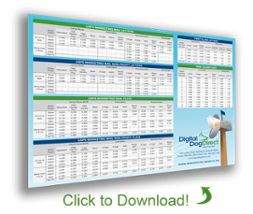
The benefits of variable data printing for direct mail marketing are simple and powerful. We all know that relevancy will drive engagement. Your customers are much more likely to engage with a marketing piece if something speaks to them personally. Variable data printing makes it possible to change images, offers, and text, driven by the data for each recipient, without stopping or slowing down the print process. This allows you to personalize your mailings, leading to higher response rates.
You don’t have to load different designs for different segments of your list. Variable Data Print software automates the process so you can customize different elements of your mailings within the same mail stream.
But how do you get started?
There are three key components of variable data printing that need to be aligned for successful direct mail marketing – data, creative, and measurement.
1) Data Drives the Bus
If you want to personalize your mailings, you need to know something about the recipient. In other words, you need good, actionable data, whether it comes from your CRM or a purchased list.
The first step is to analyze your data to find out what type of information you have, what components of each mailing you want to personalize, and for what purpose. Many people create a “Target Matrix” and assign different attributes to different creatives. So you may start out with two columns – data points on one side, creative options on the other. Then it’s just a matter of matching the items in both columns.
At a bare minimum, you have each recipient’s physical address. Even something as simple as an address allows you to customize imagery based on where they are – in a particular state or county, or an urban, suburban, or rural community.
Of course, the more data you have, the more personalized your campaigns can be. A more advanced example is to customize your messaging and offer based on a customer’s purchase history during a certain time period.
If their spending has been trending down during the past six months, you might want to send them a special offer to reverse that spending trend. If they have a history of buying golf equipment, you can extend a special invitation to check out new products as they become available or take advantage of discounts on golf products.
Ultimately, the key is to know your data and the possibilities it provides. Your marketing team or agency will need to analyze your data, pull reports, and make decisions about how to leverage different types of data based on your marketing goals.
2) Apply Data to Creative Decisions
Once you’ve segmented your data and know who you’re talking to, you can turn your attention to creative and determine how you’ll talk to them. Data will help drive design, layout, artwork, and messaging.
Would it make sense to produce multiple creatives or a single creative that uses variable data printing to automatically swap out creative components? Which of those components will you personalize and why?
For example, nonprofits often use direct mail for fundraising with great success. For recipients who have never donated, they might send a simple letter. For previous donors, they might use variable data printing to create custom inserts based on their giving history.
In this case, the customer would use three different creative approaches. Each one speaks in some form to the intended recipient. This is one simple example of how data drives creative and how variable data printing creates more options.
3) Plan for Measuring Response Before the Campaign, Not After
Always plan how you are going to track your program’s success in advance. Waiting until after mailings have been distributed to figure out how to track the campaign’s effectiveness is a costly mistake. Measurement is a critical part of the strategic planning phase.
What is the response mechanism for your campaign? What is the call-to-action? Are you directing people to make a phone call, visit a website, redeem a coupon, or attend an event?
How do you identify and classify responses to your campaign? How will you attribute activity? What are your processes for gathering and measuring this data?
Having these mechanisms in place will help you determine what’s working, what’s not, and how to apply these learnings to your next campaign. The goal is always to improve, optimize, and increase ROI.
Beyond tracking response, every direct mail campaign is an opportunity to gain information about your customers. Beyond building sales, you can build on your data. Learn more about your customers’ preferences, tendencies, and purchase behaviors so you can continue to make your campaigns more personalized and relevant.
Many people associate precise targeting, creative flexibility, and measurement with digital marketing. However, direct mail offers the same capabilities, especially when you partner with a direct mail provider who knows how to take full advantage of variable data printing.
If you’d like to discuss incorporating variable data printing into your direct mail campaigns, contact us to schedule a consultation and unleash the power of Digital Dog Direct.



Comments